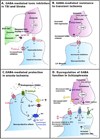GABA receptors in brain development, function, and injury
- PMID: 24820774
- PMCID: PMC4231020
- DOI: 10.1007/s11011-014-9560-1
GABA receptors in brain development, function, and injury
Abstract
This review presents a brief overview of the γ-aminobutyric acid (GABA) system in the developing and mature central nervous system (CNS) and its potential connections to pathologies of the CNS. γ-aminobutyric acid (GABA) is a major neurotransmitter expressed from the embryonic stage and throughout life. At an early developmental stage, GABA acts in an excitatory manner and is implicated in many processes of neurogenesis, including neuronal proliferation, migration, differentiation, and preliminary circuit-building, as well as the development of critical periods. In the mature CNS, GABA acts in an inhibitory manner, a switch mediated by chloride/cation transporter expression and summarized in this review. GABA also plays a role in the development of interstitial neurons of the white matter, as well as in oligodendrocyte development. Although the underlying cellular mechanisms are not yet well understood, we present current findings for the role of GABA in neurological diseases with characteristic white matter abnormalities, including anoxic-ischemic injury, periventricular leukomalacia, and schizophrenia. Development abnormalities of the GABAergic system appear particularly relevant in the etiology of schizophrenia. This review also covers the potential role of GABA in mature brain injury, namely transient ischemia, stroke, and traumatic brain injury/post-traumatic epilepsy.
Figures

References
-
- Akbarian Schahram, Huang Hsien-Sung. Molecular and Cellular Mechanisms of Altered GAD1/GAD67 Expression in Schizophrenia and Related Disorders. Brain Research Reviews. 2006 Sep;52(no. 2):293–304. - PubMed
-
- Allain Anne-Emilie, Baїri Alexia, Meyrand Pierre, Branchereau Pascal. Ontogenic Changes of the GABAergic System in the Embryonic Mouse Spinal Cord. Brain Research. 2004 Mar;1000(no. 1–2):134–147. - PubMed
-
- Anderson Stewart A, Volk David W, Lewis David A. Increased Density of Microtubule Associated Protein 2-Immunoreactive Neurons in the Prefrontal White Matter of Schizophrenic Subjects. Schizophrenia Research. 1996 May;19(no. 2–3):111–119. - PubMed
-
- Anderson SA. Interneuron Migration from Basal Forebrain to Neocortex: Dependence on Dlx Genes. Science. 1997 Oct 17;278(no. 5337):474–476. - PubMed
-
- Anderson Stewart A, Kaznowski Christine E, Horn Carrie, Rubenstein John LR, McConnell Susan K. Distinct Origins of Neocortical Projection Neurons and Interneurons In Vivo. Cerebral Cortex. 2002 Jul 1;12(no. 7):702–709. - PubMed
Publication types
MeSH terms
Substances
Grants and funding
LinkOut - more resources
Full Text Sources
Other Literature Sources

